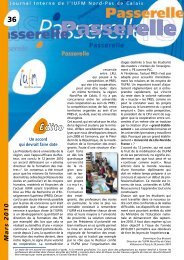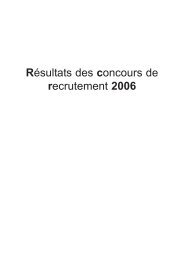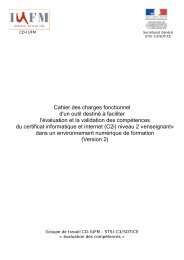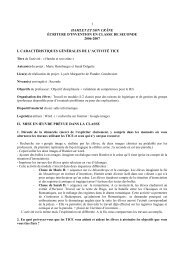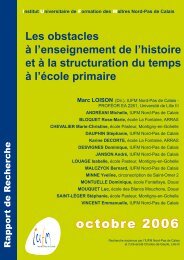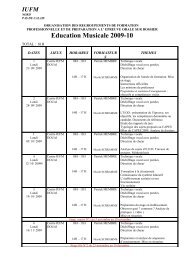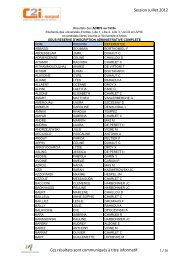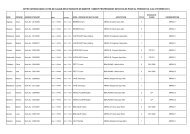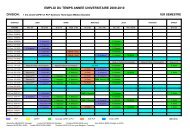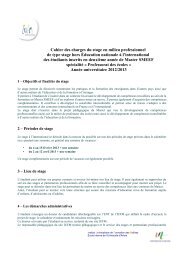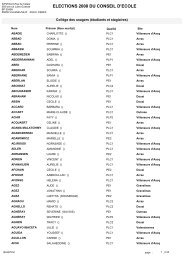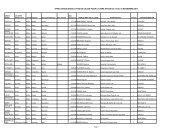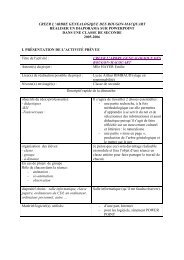You also want an ePaper? Increase the reach of your titles
YUMPU automatically turns print PDFs into web optimized ePapers that Google loves.
Figure 1 : « how to draw this figure ? »<br />
(See figure 1). It has been asked in seven different classes, by the teachers themselves,<br />
without any outside observer. It seemed then as a more or <strong>le</strong>ss ordinary task within the<br />
class. 165 texts have been col<strong>le</strong>cted of which 163 can be taken into account.<br />
It is therefore about a writing task taken from “an instruction program to reproduce a comp<strong>le</strong>x<br />
figure”. To be carried out, the writer is required first to identify and to name some of the<br />
constructib<strong>le</strong> e<strong>le</strong>ments, then to point out the constructib<strong>le</strong> relationships that exist among<br />
the different e<strong>le</strong>ments. We analyze these texts as pupils productions, that is to say we try<br />
to take into account the context in which it was done and the different pupils’ status. It is not<br />
the same for instance, for a 9 years old or a ten years old pupil to produce, as a construction<br />
program the following: “draw two perpendicular lines of which centre is the meeting point<br />
of lines and link the intersection of the two lines and of the circ<strong>le</strong>” or “trace a square, its<br />
diagonals and its centre, trace the circ<strong>le</strong> of which centre is the square’s which goes by the<br />
square’s summits” or “draw a circ<strong>le</strong> and a square inside the circ<strong>le</strong>.” As a matter of fact, the<br />
first text points out to objects and geometrical relationships between the objects that are<br />
constructib<strong>le</strong> by pupils at this school <strong>le</strong>vel. On the other hand, the second one needs the<br />
drawing of a square, which isn’t as easy for them. Lastly, the last one avoids the necessary<br />
drawings to be ab<strong>le</strong> to fit a square in a circ<strong>le</strong>. Taking into account the pupils’ school <strong>le</strong>vel and<br />
considering the outcomes as productions, we have chosen not to grade them according to<br />
how right they are, but according to the choices pupils made.<br />
We have kept as first indicators of the way pupils write, the chosen e<strong>le</strong>ments and their<br />
designations, the geometrical relationships mentioned and their designation. The<br />
corresponding indicators are the numbers of geometrical terms used, the chosen e<strong>le</strong>ments<br />
– circ<strong>le</strong>s, lines, summits etc. – relationships such as perpendicular, topological positions<br />
etc. Therefore, the point is to figure out the figure analysis pupils have chosen to make<br />
throughout what they say. The way of analyzing can be quite different from one pupil to the<br />
other. Some of them only dealt with the lines that shape the diagram : the two lines, the circ<strong>le</strong><br />
and the square, O or the four summits of square A, B, C, D. From a theoretical point of view,<br />
these two ways of looking at it are linked to different analytical skills. As a matter of fact,<br />
looking at a geometrical figure as a punctual structure requires going beyond immediate<br />
perception, which only shows lines entang<strong>le</strong>d. The use of S.I.A. makes it possib<strong>le</strong> to test the<br />
theoretical hypothesis of the different analytical stages in a geometrical diagram.<br />
112<br />
<strong>IUFM</strong> Nord-Pas de Calais




